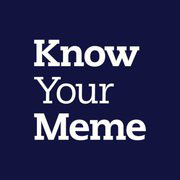What is the Internet Meme Database?
In the same way that the Human Genome Project aims to document genetic information in order to better understand the human body, KYM's Internet Meme Database aims to document the spread of culture online. By studying how we collectively develop, spread, and select our memes & other cultural artifacts we hope to identify common themes, trends, and the way our cultures are evolving.
What is the Know Your Meme show?
The "Know Your Meme" web video series was originally developed by the Rocketboom staff as "evergreen content" to air over our annual holiday vacation in Dec. 2007, and was developed into a full-fledged segment on the show through 2008. The Internet Meme Database website was launched in December 2008.
What is a meme?
A "meme" is a theoretical unit of culture, representing information spreading from one mind to another. In common usage it refers to fads, in-jokes, catchphrases and other cultural tidbits that spawn, grow, and eventually decline into obscurity as they are supplanted by newer memes.
The term "meme" was coined by biologist Richard Dawkins in his 1976 book The Selfish Gene, and the flow of memes from one mind to another is meant to be analogous to the way genes carry biological information from one generation to the next.
Why do memes spread?
Memes spread due to their inherent values. If a meme has the power to grab a person's attention, convince them to help spread it, or inspire them to create a derivative work, it can grow.
Different types of memes appeal to different types of people, and different memes are born out of different cultures, or memetic hubs.
A meme's exploitability, or ease of replication and/or manipulation is also a large contributing factor. This, like macro generators, typically increase a meme's chances of spawning derivatives, but this is usually secondary to the meme's ability to evoke an emotional response (humor, disgust, offense, intrigue, etc.) from the viewer.
What is the difference between a "meme" and a "viral video" or "____"?
[This section updated 4/9/10]
A meme consists of a body of instances of a piece of viral content. Generally, the easiest memes to spot are those that exist in the participatory creation of content.
One viral image may be exploitable, inspiring the creation of many derivatives; in which case, the meme exits in a diverse set of instances.
But there is also a meme present within the spread of links that point back to the original instance.
In the case of a single viral video, the meme exists within the sharing and reposting of the video. The video spreads by inspiring the viewer to share it. Each repost is then considered an instance of the meme.
Every meme has to be viral, but not all viral videos are memes. In order to identify the meme, you must be able to trace the route of spread.
What are some basic criteria for defining a meme?
Anyone who thinks that they’ve spotted a meme in the wild can submit an entry to the Internet Meme Database. Once in the MemeDB, entries are evaluated by the KYM community based on six primary concepts:
1) Viral Spread: search results, social media mentions, forum posts, route of spread.
2) Point of Origin: Find out where the meme first appeared and provide proof that it spread beyond its original subculture.
3) Derivatives/instances: Existing volume of spoofs, mashups, remixes, parodies, recontextualizations, and re-enactments. Is it mutating?
4) Appearance in Memetic Hubs: Websites and communities that have been made famous for spreading and culturing memes.
5) Organic / Forced Memes: Was the meme spread peer to peer or was it astroturfed? Even astroturfed phenomena can become memes.
6) Spin-offs / Sub-memes (Optional): Many memes spawn entire trees of sub-memes.
How can I create a meme?
Memes aren't created -- they occur when a particularly interesting piece of content floats around the internet and begins to be passed around, written about, talked about, remixed, and generally absorbed into our cultural consciousness.
Although it is possible for a person to create the conditions that would be ideal for a meme to form, it is impossible to guarantee that others will participate. If all derivatives within the body of the supposed meme are created by an individual or small, coordinated group of people, then it is not a genuine meme.
Do not confuse memes with the content itself -- memes live outside the content, above it, and around it. Very often the meme involves numerous pieces of content: the original, reposts of the original, as well as the remixes and derivatives; all of which reflect the spread of the meme.
What is a forced meme?
A meme in it's purest sense is an idea that spreads because of genuine interest. A forced meme is generally something that has been written about or spammed excessively, or otherwise declared as a meme prior to proof of organic spread or interest. However, it should be noted that if user interest picks up, a forced meme can sometimes succeed in generating interest.
Isn't a meme a meme, regardless of the Internet?
Sure, there are memes everywhere you look, but Know Your Meme is primarily focused on memes that form online and spread because of the internet. Popular culture that results from other media without the need of internet propagation (where's the beef, Get R Done) is not the type of material that we accept into the database. Memes such as "LOLcats" and "All Your Base Are Belong to Us" required the internet to spread, propagate, and mutate, making them "internet memes" rather than just plain "in real life memes" (IRL memes).
What is astroturfing?
Astroturfing occurs when a viral video or other phenomenon is staged or faked by an organization or other group of connected individuals looking to promote a product, yet hide the fact that they are advertising. Knowing the difference between a grassroots movement and an astroturf movement is essential when considering a meme's legitimacy.
Your site contains content that I find offensive. Why don't you remove it?
There are many phenomena that spread not because they are funny, but because they are offensive. Obscenity grabs attention. That attention, whether positive or negative, propagates the meme and we feel that this is a phenomenon worth documenting. Know Your Meme does not condone discrimination based on race, gender, sexual orientation, faith, political affiliation, or loyalty to sports teams.
Why is the Meme Database split into four sections?
The Meme Database is split into four sections: Featured, Confirmed, Submssions, and Deadpool. This is where all the meme entries created are listed, be they actually a meme or not.
What is Submissions?
When a new entry is submitted to the database, it enters the Submissions queue. Here, the meme entry will be reviewed by the Know Your Meme staff, edited, and fact-checked before being moved to the "Confirmed" section. Only entries about memes that already exist are valid for consideration to the meme database. This is not be used for trying to create your own new meme. These are rather easy to spot.
What is Confirmed?
Once a Know Your Meme admin has confirmed that the meme entry is factual and accurately represents all pertinent information regarding the meme itself, its route of spread, its appeal (what makes it spread), and any other memetic qualities, it is moved to the "Confirmed" section.
What is Featured?
There are two reasons for a meme entry to be Featured.
If a meme is currently showing signs of enormous viral spread, it may sometimes be Featured while still undergoing evaluation in the Submissions Section.
Older meme entries that have been thoroughly confirmed are also selected by Know Your Meme staff if the entry is exceptionally well-written, full of information and citations, such as origins and spreading habits, as well as meme usage and derivatives.
What is Deadpool?
If a meme submission fails to provide any proof of the meme's spread or popularity, appears to be an attempt at "meme forcing", or otherwise doesn't fit our criteria for classifying a phenomenon as a meme entry, it is moved to the Deadpool section. Deadpooled meme entries serve as reminders that the subject has been previously submitted, but has been judged as being irrelevant to the database.
How long will my entry take before being confirmed? Why isn't it confirmed yet?
This is entirely dependent on the amount of editing required on the part of the meme entry editors and administrators. A meme entry is meant to be a factual, unbiased, and mostly objective explanation of a meme. Some meme entries can be confirmed within hours, while others may sit in Submissions for months. The burden of proof of memetic essence lies on the part of the meme submitter.
How can I write a meme entry that will be confirmed fast?
- Avoid writing in the first person.
- Avoid hyperbolic statements such as "this is the best meme in history."
- Be objective. Whether you personally love or hate the subject you are presenting, state how it has been received and the impact that the meme has caused. Your opinions are respected, but please keep your opinion to a minimum within your entries. The database is only concerned with archiving memes at a neutral point of view, not biased opinion.
- Cite your sources! Since every statement must be fact-checked, providing a link to where your information was obtained is required.
- You are allowed to add photos to any article, even if it isn't yours. Adding pictures to submitted entries may help get the article confirmed. Please only submit "found" photos to memes in submissions. Do not create images for the purpose of having an entry confirmed.
- Submitting your own images to Confirmed memes is okay.
- Do not plagiarize other articles. Although there are other sources that do a great job of explaining a meme, quote brief excerpts where neccessary rather than simply copying and pasting.
- When appropriate, provide metrics such as Google Insights, Trendistic graphs, Youtube Stats, and/or other data.
- Direct links to Wikipedia, YTMND Wiki, Encyclopedia Dramatica, and Macrochan are provided. Use them!
- If the meme is present in other forms of media such as TV and film, make the distinction between whether the meme is mainstream-sourced, or mainstream-derived. Pop culture can be remixed online and sometimes qualify as an Internet meme, but if the derivatives were being created by other mainstream sources at the same time, then the meme has more to do with general pop culture than Internet culture.
I have new information about something that already exists in the MemeDB. How do I add it to the entry?
There are a few useful ways to do so if you have signed in to the website:
- You can use the "Suggest change" button in the upper-right corner of any entry, in order to submit your information that will then be checked and added to the entry.
- You can mail, via wall posts or private messages, the initial author or any admin to ask if you can apply for editorship and then be marked as "editor" of that entry. You will then be able to add changes yourself that way.
If you don't want to register but still want to add any information on an entry, you can either use the "contact" button at the bottom right corner of the front page, or send a mail to info@knowyourmeme.com
How do I make big bold headings?
The KYM Database accepts some HTML and Textile formatting.
To make bold headings, type "h2." prior to your heading.
Example:
h2. About
In meme entries, the available formats may be found above the body section. In the forums, they are found above the posting box.
How do I embed a Youtube video?
On a Youtube video's page, underneath the description, there are two boxes containing some code that can be utilized for sharing the video, just underneath the video's description. The 2nd box, next to the word "embed" contains the HTML code necessary for embedding a video. Copy that code, and paste it within the body of your meme entry.
Why did my meme entry get Deadpooled?
An entry can be deadpooled for the following reasons:
- Lack of notability: The phenomenon is restricted to a single area, or the view counts are too low. It does not provide any proof of expansion, spread, or interest from any other websites.
- Lack of derivatives: There are not enough parodies, pastiches, imitations or reuses of the initial phenomenon to consider it as a meme.
- Lack of recontextualization: The catch-phrase is used only within it's original context, as a direct reference to the source material rather than used in any new context, neither reuse outside of its initial context nor repurpose.
- Attempted "meme forcing": When there are traces of a phenomenon being seen as a meme or being used in order to become a meme before it hasn't even caught on. (That is to say, if a meme has been seen as forced but created a genuine interest that's lasting, the "deadpooled" status can removed.
- Astroturf: When there are signs of a phenomenon being pushed by marketing experts, while lacking un-solicited participation. Here, the trend becomes artificial and loses its genuine, as well as "organic", essence.
- Duplicates: Only one entry on each meme is necessary. If a meme is submitted more than once, the duplicate entries will be deadpooled. If you don't know if a meme has already been submitted, use the search bar at the upper-right corner of the site to check.
- Junk Entries: On occasion, the database receives entries that could only be described as junk. Spam entries, troll entries, advertising of one's own website, and blank entries are frowned upon, and are of course, sent to the deadpool or hidden.
Can a deadpooled entry be un-deadpooled?
Yes. If new information is presented, a deadpool can be appealed and moved back to Submissions, so if you have new information, post it in the comments section or email the research team at research@knowyourmeme.com. You may also use the Suggest Changes link at the top of the page.
Tomberry's Suggestions (slightly edited by Jostin)
A note to newcomers
When you want to submit an entry, it is proper courtesy to, if you don’t feel like doing extensive research, make the littlest bit of effort in explaining in even only a few lines why you think your entry has memetic properties on the internet.
Posting only one line that is barely related to the entry, only one photo, or a video without any text is just as confusing as ever. Understand that not everybody will know at first what you could be talking about.
What do all these "+1 Deadpool/work/confirm" mean?
As you read through the comments of any entry, you’ll undoubtedly stumble upon a “+1 thing”.
This kind of comment was initially used by the Admins to tell another admin when they were ready to confirm/deadpool an entry and that they were awaiting for another opinion on it.
Overtime, it has then been utilized by all users but they mustn’t be taken seriously or for granted. This is because even the newest of newcomers are jumping in on it and they usually don't know what they are doing.
We invite you to not lose your temper with other users' comments as well as to look for the comments that are adding arguments in their opinions as these are more likely to help you.







